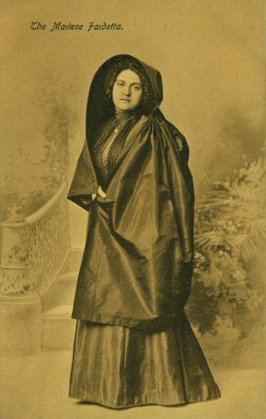Għonnella
Għonnella (pronounced awe-nel-la) is a traditional Maltese headdress worn by women. It is also known as Faldetta or Maltese hood. The għonnella was a distinctive part of Maltese women's attire from the 16th century until the early 20th century.
History[edit | edit source]
The origins of the għonnella are somewhat unclear, but it is believed to have evolved from similar headdresses worn in the Mediterranean region. The għonnella became a symbol of Maltese identity and was commonly worn by women of all social classes. It was particularly popular during the Knights of St. John period.
Design[edit | edit source]
The għonnella is made from a large piece of black or dark-colored fabric, often silk or cotton. It is draped over the head and shoulders, with one end thrown over the left shoulder and the other end held in place by the left hand. The fabric is pleated and gathered to create a hood-like effect, which frames the face and provides protection from the sun and wind.
Cultural Significance[edit | edit source]
The għonnella was more than just a piece of clothing; it was a symbol of modesty and respectability. Women wore it to church, markets, and social gatherings. The headdress also served as a form of non-verbal communication, with the way it was worn indicating the wearer's social status and marital status.
Decline in Use[edit | edit source]
The use of the għonnella began to decline in the early 20th century, as Western fashion started to influence Maltese clothing styles. By the mid-20th century, the għonnella had largely disappeared from everyday use, although it is still worn on special occasions and by cultural groups.
Modern Day[edit | edit source]
Today, the għonnella is considered an important part of Maltese culture and heritage. It is often displayed in museums and cultural exhibitions. Efforts are being made to preserve the knowledge and craftsmanship involved in making the għonnella.
See Also[edit | edit source]
References[edit | edit source]
External Links[edit | edit source]
Search WikiMD
Ad.Tired of being Overweight? Try W8MD's NYC physician weight loss.
Semaglutide (Ozempic / Wegovy and Tirzepatide (Mounjaro / Zepbound) available. Call 718 946 5500.
Advertise on WikiMD
|
WikiMD's Wellness Encyclopedia |
| Let Food Be Thy Medicine Medicine Thy Food - Hippocrates |
Translate this page: - East Asian
中文,
日本,
한국어,
South Asian
हिन्दी,
தமிழ்,
తెలుగు,
Urdu,
ಕನ್ನಡ,
Southeast Asian
Indonesian,
Vietnamese,
Thai,
မြန်မာဘာသာ,
বাংলা
European
español,
Deutsch,
français,
Greek,
português do Brasil,
polski,
română,
русский,
Nederlands,
norsk,
svenska,
suomi,
Italian
Middle Eastern & African
عربى,
Turkish,
Persian,
Hebrew,
Afrikaans,
isiZulu,
Kiswahili,
Other
Bulgarian,
Hungarian,
Czech,
Swedish,
മലയാളം,
मराठी,
ਪੰਜਾਬੀ,
ગુજરાતી,
Portuguese,
Ukrainian
Medical Disclaimer: WikiMD is not a substitute for professional medical advice. The information on WikiMD is provided as an information resource only, may be incorrect, outdated or misleading, and is not to be used or relied on for any diagnostic or treatment purposes. Please consult your health care provider before making any healthcare decisions or for guidance about a specific medical condition. WikiMD expressly disclaims responsibility, and shall have no liability, for any damages, loss, injury, or liability whatsoever suffered as a result of your reliance on the information contained in this site. By visiting this site you agree to the foregoing terms and conditions, which may from time to time be changed or supplemented by WikiMD. If you do not agree to the foregoing terms and conditions, you should not enter or use this site. See full disclaimer.
Credits:Most images are courtesy of Wikimedia commons, and templates, categories Wikipedia, licensed under CC BY SA or similar.
Contributors: Prab R. Tumpati, MD



